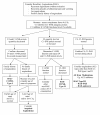2010 International consensus algorithm for the diagnosis, therapy and management of hereditary angioedema
- PMID: 20667127
- PMCID: PMC2921362
- DOI: 10.1186/1710-1492-6-24
2010 International consensus algorithm for the diagnosis, therapy and management of hereditary angioedema
Abstract
Background: We published the Canadian 2003 International Consensus Algorithm for the Diagnosis, Therapy, and Management of Hereditary Angioedema (HAE; C1 inhibitor [C1-INH] deficiency) and updated this as Hereditary angioedema: a current state-of-the-art review: Canadian Hungarian 2007 International Consensus Algorithm for the Diagnosis, Therapy, and Management of Hereditary Angioedema.
Objective: To update the International Consensus Algorithm for the Diagnosis, Therapy and Management of Hereditary Angioedema (circa 2010).
Methods: The Canadian Hereditary Angioedema Network (CHAEN)/Réseau Canadien d'angioédème héréditaire (RCAH) http://www.haecanada.com and cosponsors University of Calgary and the Canadian Society of Allergy and Clinical Immunology (with an unrestricted educational grant from CSL Behring) held our third Conference May 15th to 16th, 2010 in Toronto Canada to update our consensus approach. The Consensus document was reviewed at the meeting and then circulated for review.
Results: This manuscript is the 2010 International Consensus Algorithm for the Diagnosis, Therapy and Management of Hereditary Angioedema that resulted from that conference.
Conclusions: Consensus approach is only an interim guide to a complex disorder such as HAE and should be replaced as soon as possible with large phase III and IV clinical trials, meta analyses, and using data base registry validation of approaches including quality of life and cost benefit analyses, followed by large head-to-head clinical trials and then evidence-based guidelines and standards for HAE disease management.
Figures
References
-
- Blohme G. Treatment of hereditary angioneurotic oedema with tranexamic acid: A random double-blind cross-over study. Acta Med Scand. 1972;192:293–298. - PubMed
LinkOut - more resources
Full Text Sources
Other Literature Sources
Medical




